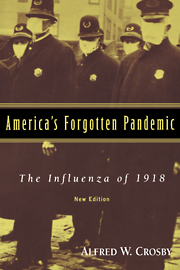Book contents
- Frontmatter
- Contents
- List of Graphs and Tables
- Preface to the New Edition
- PART I An Abrupt Introduction to Spanish Influenza
- PART II Spanish Influenza: The First Wave—Spring and Summer, 1918
- PART III The Second and Third Waves
- PART IV Measurements, Research, Conclusions, and Confusions
- 11 Statistics, Definitions, and Speculation
- 12 Samoa and Alaska
- 13 Research, Frustration, and the Isolation of the Virus
- 14 Where Did the Flu of 1918 Go?
- PART V Afterword
- Index
14 - Where Did the Flu of 1918 Go?
Published online by Cambridge University Press: 05 June 2012
- Frontmatter
- Contents
- List of Graphs and Tables
- Preface to the New Edition
- PART I An Abrupt Introduction to Spanish Influenza
- PART II Spanish Influenza: The First Wave—Spring and Summer, 1918
- PART III The Second and Third Waves
- PART IV Measurements, Research, Conclusions, and Confusions
- 11 Statistics, Definitions, and Speculation
- 12 Samoa and Alaska
- 13 Research, Frustration, and the Isolation of the Virus
- 14 Where Did the Flu of 1918 Go?
- PART V Afterword
- Index
Summary
The objective of influenza research, says Sir MacFarlane Burnet, is “the understanding of the conditions responsible for pandemic influenza of the 1918 type—and the establishment of conditions necessary to prevent its reappearance.” Humanity can afford to ignore the virus of common flu, such as that personally cultured by Wilson Smith, which brings two days of misery and a fortnight of feebleness, and elicits names like the “jolly rant”; but the virus of 1918 produced a disease that turned people the color of wet ashes and drowned them in the fluids of their own bodies and inspired names like the “purple death.” The discovery of Smith, Andrewes, and Laidlaw, however brilliant, was of the virus of 1933, not that of 1918, the real object of their and all their colleagues' concern. It has been the dream of scientists working on influenza for over a half century to somehow obtain specimens of the virus of Spanish influenza, but only something as unlikely as a time capsule could provide them.
One of the few things known for certain about influenza in 1918 and for some years after was that it was, outside the laboratory, exclusively a disease of human beings. There was a tradition several hundred years old that a wide assortment of domesticated animals—horses, cattle, sheep, dogs, cats—were susceptible to flu, and in 1894 no less a savant than Charles Creighton in his massive History of Epidemics in Britain claimed that epidemics of flu in 1657-1659, 1688, 1727, 1732, 1737, and 1760 in humans had been preceded or accompanied by epidemics of respiratory illness in horses.
- Type
- Chapter
- Information
- America's Forgotten PandemicThe Influenza of 1918, pp. 299 - 312Publisher: Cambridge University PressPrint publication year: 2003
- 1
- Cited by



